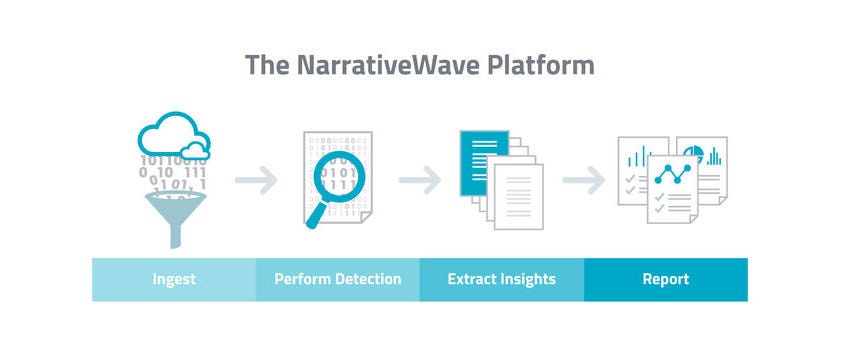The Value of Detection for IoT Platforms & Manufacturers
NarrativeWave’s Director of Customer Engagement, Johnny Dobbins, discusses the true value of detection for IoT (Internet of Things) Platforms and Industrial Manufacturers.
Today, there are 28 billion devices connected to the internet and each device sends multiple data points per second. Not only is the amount of data being collected from these devices rapidly increasing, there is expected to be 50 billion connected devices by 2020. (Business Insider, July 2016) Processing billions of data points daily has already become a technological challenge for many enterprises and manufacturers. Imagine what processing data will be like by 2020?
How can all this data become an asset to organizations? The raw data alone is not useful. To get actionable business insights, the data must be analyzed, which can be achieved by using an IoT (Internet of Things) platform or a software solution.

We sat down with Johnny Dobbins, the Director of Customer Engagement at NarrativeWave, to learn more about the true value of detection for IoT Platforms. Johnny has 20 years of experience architecting content and data management solutions. At NarrativeWave, Johnny has been an integral part of building the first Industrial Internet solution focused on combining detection, natural language generation, and data science to produce auto-generated actionable business insights.
What is the importance of detection when it comes to the Internet of Things?
IoT platforms range greatly in terms of features, but the idea is to ingest and analyze data, then monitor, detect, and predict. Most platforms don’t provide an all-encompassing solution and it is common for organizations to use more than one platform to get the desired results. One of the most important components within a platform is detection, which is the process of finding unusual behavior (an anomaly) that differs from what has been observed in the past or from what is expected.
How is detection used within IoT Platforms?
Detection can be used in multiple ways within IoT platforms. The first method of detection includes looking at previous data within the model to provide a historical review. Another method is to compare data with predictive patterns, which are created based on both historical and current data within the model. Lastly, a real-time, or near real-time approach uses either the historical or predictive method, but returns a live analysis of events to view anomalies that may or may not be actively occurring within the data.
What is the overall goal of detection?
The detection process is significant not only for discovering unusual behavior, but also predicting future behavior. The main goal of prediction is to prevent. This is extremely important within the Industrial IoT space. We often don’t think about the large industrial equipment that costs hundreds of millions of dollars and powers our daily lives, such as airplane engines or power generators that provide electricity to entire cities. With prediction, IoT platforms can prevent costly equipment failures and potentially save lives. Prediction is only possible though with a detection model in place that defines what to look for and identifies patterns.
How is detection used within the NarrativeWave Platform?
One of the unique aspects of the NarrativeWave platform is that we developed an intuitive pipeline, enabling users to create and manage their own detection models, through a simple web interface. The platform is user-directed, managed and utilized by engineers, without the ongoing need of developers or data scientists, which allows for immediate impact on the operations of their business and for their clients.
Imagine a toolset that provides engineers with a near real-time interface to iterate and modify new or existing detection models that impact business decisions within their operational workflow. Engineers can now detect events in their data and invalidate those events using NarrativeWave. This is the raw power provided by the NarrativeWave platform that directly impacts their business and allows engineers to “do more with less”.

NarrativeWave is a user-directed platform that engineers will rely on as part of their daily workflow. For the first time, engineers are finally being leveraged in the best way to impact their company’s internal operations. Engineers can now focus on serving their clients, not spending repetitive hours doing research or manual tasks that limit their effectiveness. Most importantly, they can better execute their roles and business outcomes, without the need of a software engineer, data scientist or outside software vendor.
What are the challenges of building detection?
One of the biggest challenges of building detection within an IoT Platform is fine tuning the detection model to specific data, hardware, or equipment. For example, a model built to detect high temperature on a turbine in Boston would have a different temperature threshold than a model built for a turbine based in Saudi Arabia. The difference in weather temperament is so extreme that specific thresholds need to be in place for the equipment in each location.
What value does detection provide to NarrativeWave customers?
One of our large enterprise clients has a robust analysis setup with three detection models and each have over fifty threshold variants based on the equipment model. The client’s iteration process use to take three to four months and that timeframe has been dramatically reduced since using the NarrativeWave platform. More importantly, this client can now setup iterations on their own, with minimal interaction or daily support from our customer engagement team. A process that used to take up to 16 hours, now provides a business outcome in less than 5 minutes with the additional benefit of improved accuracy.
The detection process within IoT Platforms provides significant value to users for managing their current processes, but also predicting future behaviors. As more devices are connected to the Industrial Internet, detection will play a crucial role in efficiently reporting on operational data and business insights. The business outcome provided by NarrativeWave will provide significant productivity savings for manufacturers and their clients. Lastly, for other IoT Platforms and large industrial manufacturers, there is a future recurring revenue component that will be achieved using NarrativeWave.
Website: www.narrativewave.com
LinkedIn: www.linkedin.com/company/narrativewave
Facebook: www.facebook.com/narrativewave
Twitter: @narrativew
Inquiries: marketing@narrativewave.com

